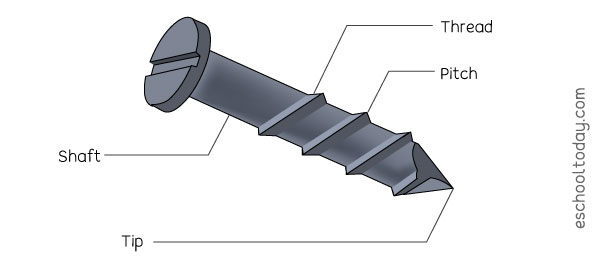- Simple Machines
What is a Screw?
A screw is simply an inclined plane around a cylinder. To describe this better, you can view it as a cylinder with a head (solid top) at one end and a pointed tip (like a nail) at the other end. More importantly, it has ridges winding around it. The correct term for the ridges (or grooves) around the shaft or cylinder is the thread.

The distance between threads is the same for each screw but is different on other screws. The distance between threads is called a Pitch.
Screws are useful for holding things together. They can pull or push an object together. They can be used to lift heavy items and tighten things too.
Nail and Screw
These two are not the same. Unlike the nail, a screw has ridges around the shaft. It is harder to drive a screw into a piece of wood because the ridges on the screw create a lot of friction and resistance. To drive a screw into the wood, it has to turn in a circular motion by a screw-driver.
Other kinds of screws

- Bolt:
A bolt is a kind of screw but does not have a pointed tip. A bolt is not drilled into place, but rather, a hole is made for the bolt to go through. Then a nut is placed at the end to screw the bolt through. Bolts are powerful in holding things together. - Drill Bit:
It is a type of screw that can make holes in wood, plastic, metal, and stones when attached to an electric drill. Like the regular drill, it is pointed at one end, and it has threads too. The drill bit has deeper grooves that carry pieces of wood from the hole to the surface as the drill bit turns.
Examples of screws
Some good examples of screws are bolts, screws, bottle tops, guitar tuners, light bulbs, faucet taps, and cork openers. Can you think of a screw device in your home?
Mechanical Advantage
Mechanical advantage depends on the space between the threads and the length (and thickness) of the screw. The closer the threads are, the greater the mechanical advantage. It is easier to drive a screw into an object if the thread spacing is smaller. It takes less effort but more turns. If the spaces between the threads are wider, it is harder to drill a screw into an object. It takes more effort but fewer turns.
